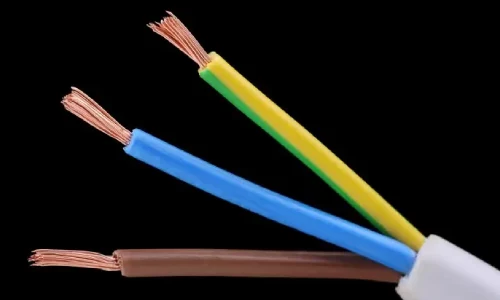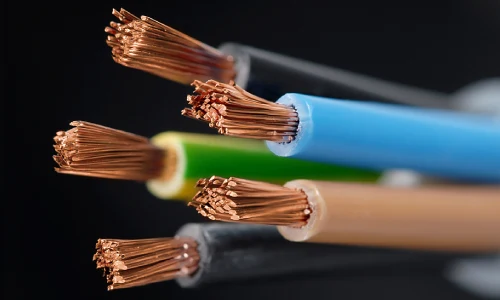Electrical wiring colors
Do you know the color of the electrical wiring? Which color of electrical wiring is used in buildings and houses? So, stay with us until the end of this article to learn about the different colors of electrical wiring.
Electrical wiring is available in different colors and types depending on the type of wire and its use. Electrical wiring refers to electrical components that are used to pass electricity through the building for lighting, heating, electricity and telecommunications. Electrical wiring is also used in industrial environments and cars.

Below is a list of common electrical wire colors and their uses:
- Black: Black wires are usually used for general purpose applications such as lighting fixtures or outlets.
- Blue: Another color of electrical wiring Blue wires are mainly used for telephone lines in homes and offices, but can also be used in other applications such as security systems or computer networks.
- Brown: Brown wires are usually used for grounding purposes, but may also be used to carry low voltage power to sensors or other devices.
- Green: Green wires are usually used as ground wires, but may carry low voltage power to sensors or other devices.
- Orange: Orange wires usually carry high-voltage alternating current directly from source to destination without first being stepped down by a transformer (as black, blue, and brown wires do). Orange electrical wiring is often found at higher voltages than other common color codes such as red or yellow because it requires more insulating material around it than at lower voltages.
What is the color code of electrical wiring of the house?
The standard color code for house wiring is:
- White: Neutral (returns current to the power supply)
- Black: hot (provides load current)
- Green: Ground (used to provide a path for current to flow to ground, such as ground)
- Blue: Conductor connecting wire (used to create a low resistance path between the hot and neutral wires)
Home wiring color coding is a standard system that helps electricians identify the wires in your home’s electrical box. Wiring color codes have been around for over 100 years and are used by electricians around the world.

Electrical wiring color codes are based on American National Standards Institute (ANSI) standards for residential wiring. These standards specify the colors and titles used in all electrical equipment and parts, including circuit breakers, switches, sockets, etc.
This standard also specifies which wires are hot (carrying power) and which are neutral (return power). This allows an electrician to quickly find the right wire to connect to an appliance when installing new wiring or repairing existing lines.
Although there are many variations of this standard, most have 20 different colors representing each letter of the alphabet (A through T) along with black and white. Letters are assigned meanings based on their position in a certain circuit. For example, one wire may be labeled red/blue while the other is red/white/green/yellow/black/brown/orange/pink with white stripes on it.
It is important to note that not all colors are used in all situations. In some cases, a different color wire may be used instead of black or white wire. Depending on the country you are in and the type of electrical wiring system you have, the code can also be different.
The most common type of home wiring color code uses four wires: black, white, red, and green/yellow (bare). These wires are commonly found in older homes with knob and tube (K&T) wiring systems. K&T was widely used from about 1880 until the 1950s, when it was replaced by modern electrical systems that used insulated cables instead of bare wires running through walls and ceilings.
What is K & T wiring?
K & T was named after its two developers: Carl Krumme (1919-1843) and William Sweatt Murray (1924-1845). They developed this system because copper had become too expensive for the average homeowner in the post-Civil War era.

What is the black wire in electricity?
Another color of electrical wiring is black wires. A black electric wire is a wire that is black in color. In the electrical circuit, black wire is used as ground for electrical wiring.
The purpose of grounding is to return any stray current to the power supply so that it does not damage anything else in the circuit.

The black wire is a ground wire for your electrical system. It should be attached to a ground rod or a bare metal surface of your home structure. The ground wire provides a path for electrical current to return to the source in the event of a short circuit. Ground wires are usually 14 gauge or larger red, but can also be white or green.
what is blue wire in electrical?
Blue wire is another color of electrical wiring in buildings and homes. It is used for telephone wiring and may not be present in all homes or buildings with older electrical systems. You should leave this wire alone unless instructed by an electrician to connect it elsewhere on your switch box.
what is the white wire in electrical?
White wire is another color of electrical wiring that is often used as a neutral wire. It is also used as a ground wire, although it does not need to be connected to ground.

It can be said that black and white wires are the most common wires that you see in homes today. They are usually 14 gauge copper wire with white or gray insulation around them. Black and white wires are both used as hot wires and carry the current that flows through your home to turn on lights and appliances.
At the end
We hope that by reading this article, you have obtained useful information about the color of electrical wiring. For wiring your house or apartment in Canada, contact the experts of Bond Electric, which is known as electrical services in Canada.
